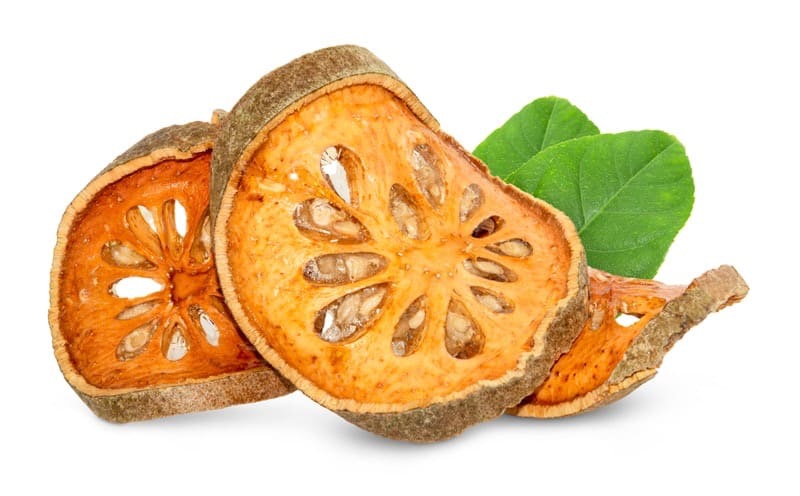
Introduction:
Aegle marmelos – Bael Tree, Golden Apple or Bengal Quince – is a mid-size, slow-growing deciduous tree native to India growing up to 18m in the right conditions. The fruits, leaves, twigs and root of the Bael tree are used medicinally. Its fruits are used in traditional medicine, and as a food. It requires a pronounced dry season to give fruit. The orange fruits have an aromatic, pleasant-flavoured yellow pulp that is eaten either fresh or dry. The leaves and small shoots are eaten as salad greens. Flowers are fragrant.
Nutritional Value:
| Nutrients | Percentage content (%) |
| Proteins | 1.80 |
| Fats | 0.30 |
| Minerals | 1.70 |
| Fibre | 2.90 |
| Carbohydrates | 31.80 |
| Calcium | 0.085 |
| Phosphorous | 0.050 |
| Potassium | 0.60 |
| Vitamin C | 0.008 |
- Other than these nutrients, it also contains various essential amino acids, vitamins B1 and B2 and phytochemicals.
- It is observed that Bael contains the highest amount of alkaloids, flavonoids and tannins compared to other medicinal plants.
I have observed that Bael fruit has been traditionally used for the management of jaundice. Bael contains compounds that help in improving liver function and promoting the elimination of toxins from the body. These properties of Bael may support the recovery from jaundice and help in restoring normal liver function.Dr. Siddharth Gupta, MD
Uses & Benefits:
- Antimicrobial
- Anti-Inflammatory
- Hepatoprotective
- Anti-Diarrheal
- Anti-Mutagenic / Anti-Genotoxic (Prevent DNA damage)
- Radioprotective (Protects the body from harmful effects of radiation)
- Anti-Cancer
- Anti-Pyretic (Fever-Reducing)
- Anti-Ulcer
- Diuretic
Uses of Bael for Diabetes:
According to animal studies, oral intake or injection of Bael fruit extract might help to lower blood glucose and haemoglobin-bound glucose levels. It might also help increase the level of insulin in the blood and might help the conversion of glucose in the liver. Certain compounds (coumarins) present in the bael fruit extract might help in the secretion of insulin from the liver, thus might be helpful in lowering blood sugar levels.
Furthermore, as per a clinical trial, lowering of blood cholesterol and slight lowering of blood glucose might be possible in some patients with diabetes to whom Bael leaf extract was administered. However, more research is required. Kindly consult a doctor for seriosu conditions such as diabetes which must be diagnosed and treated by a doctor.
How to Use Bael?
Bael is a traditional medicinal plant, and all of its parts are utilised for their various therapeutic properties. The parts that can be used are:
- Leaves
- Flowers
- Root bark
- Fruit (both ripe and unripe)
- Seed
Your Ayurvedic physician will prescribe you the form and dosage as per your health condition.
How to make bael juice?
It is a traditional recipe commonly found in the households of North Eastern India, especially during summers.
Take bael fruit, wash it and break the hard shell from all around. Once it broke, remove the pulp in a bowl. Mash the pulp till it softens and strain the mixture to remove any solid particles or impurities. You can add chilled milk, cardamom powder, jaggery, and black salt to the bael pulp if you want.
Research:
1. Patkar A, Desai N, Ranage A, Kalekar K. A review on AEGLE MARMELOS: A potential medicinal tree. Int Res J Pharm. 2012;3(8):86–91. Available from: https://www.researchgate.net/publication/292739276_A_review_on_Aegle_marmelos_a_potential_medicinal_tree
2. Dhankhar S, Ruhil S, Balhara M, Dhankhar S, Chhillar AK. Aegle marmelos (Linn.) Correa: A potential source of Phytomedicine. J Med Plants Res. 2011;5(9):1497–507. Available from: https://academicjournals.org/article/article1380546385_Dhankhar%20et%20el.pdf
3. Pradesh M, Nadu T. Health Benefits of Bael Fruit Botanical Information on Fruit. :3–5. Available from: https://vikaspedia.in/health/ayush/ayurveda-1/ayurvedic-herbal-healing/health-benefits-of-bael-fruit
4. Mujeeb F, Bajpai P, Pathak N. Phytochemical evaluation, antimicrobial activity, and determination of bioactive components from leaves of aegle marmelos. Biomed Res Int. 2014;2014. Available from: https://www.hindawi.com/journals/bmri/2014/497606/
5. Rahman S, Parvin R. Therapeutic potential of Aegle marmelos (L.)-An overview. Asian Pacific J Trop Dis. 2014;4(1):71–7. Available from: https://www.ncbi.nlm.nih.gov/pmc/articles/PMC4027346/
6. https://pfaf.org/user/Plant.aspx?LatinName=Aegle+marmelos
7. https://pharmeasy.in/blog/ayurveda-uses-benefits-side-effects-of-bael/
Disclaimer: The information included here is for educational purposes only and is not intended to be a substitute for medical treatment by a healthcare professional. Because of unique individual needs, the reader should consult their physician to determine the appropriateness of the information for the reader’s situation.